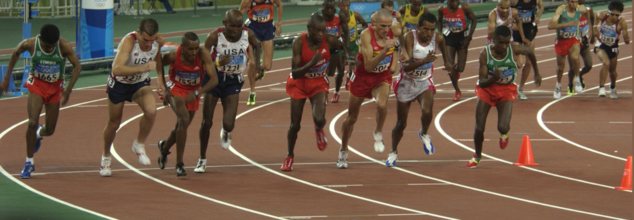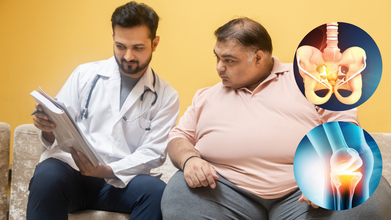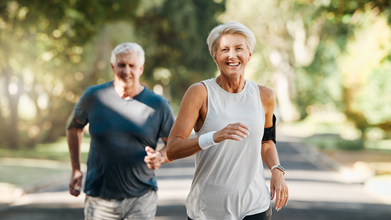- Health Conditions A-Z
- Health & Wellness
- Nutrition
- Fitness
- Health News
- Ayurveda
- Videos
- Medicine A-Z
- Parenting
5 Olympic Sports That Burn The Most Calories- Ranked By Experts

Image Credit: Canva
Whether it is sprinting down a track, swimming through waves, or pedaling at breakneck speeds, different activities require different expenditures of energy. Some sports call for short, explosive bursts of power, while others test endurance over hours. The number of calories burned depends on the sport, intensity, and the athlete's unique physiology. Most Calorie-Intensive Olympic Sports : Provides a peek into the physical demands faced by athletes as well as inspiration for anyone looking to gain insight into energy use in peak performance.
The Olympics witness over 200 countries competing in more than 300 events, one can't help but wonder: which Olympic sport demands the most from the body in terms of calories burned? While every event requires exceptional physical and mental fortitude, some sports stand out as calorie-torching powerhouses. Let's break it down.
Understanding calorie burn begins with the metric of kcal/kg/hour — calories burned per kilogram of body weight per hour. To put this into perspective, an average adult weighing 185 pounds (84 kg) burns 1 kcal/kg/hour while at rest. Activities that exceed 6 kcal/kg/hour are classified as "vigorous" by the Physical Activity Guidelines for Americans. However, the caloric expenditure of Olympic sports depends on two key factors:
1. The energy surge or intensity needed in a particular moment.
2. The absolute amount of energy used throughout the period of an event.
Does Running Burn Calories?
Running, especially sprinting and marathons, takes the cake in burning calories. Sprinting is all about short bursts of high intensity, and therefore requires explosive energy. For example, a study by a physiology expert, Pietro di Prampero, reveals that in the first 0.85 seconds of the world record by Usain Bolt in the 100-meter sprint, he burnt 91.2 kcal/kg/hour.
But over all, marathons win sprints because marathons consume more energy in totality. The energy consumption per kilometer by long-distance running is approximately 1 kcal/kg. Thus, for a marathon, which runs 42 kilometers, the energy consumption will be about 42 kcal/kg.
Let's consider Eliud Kipchoge, who won the Tokyo 2020 marathon gold. At 115 pounds (52 kg), he must have burned about 2,339 calories for his 2-hour, 8-minute run, translating to 21 kcal/kg/hour.
Also Read: How Many Calories Does Walking 12,000 Steps Burn? Tips For Reaching Your Goal
Is Swimming An Silent Calorie Crusher?
Swimming is compared to running in terms of expenditure as caloric demands can vary with stroke, environment, and skill of the athlete. One study, for example was published in 2006 in the International Journal of Sports Medicine and calculated that at a swim speed of 1.6 m/s breaststroke burns 30.4 kcal/kg/hour.
Environmental factors, such as waves and cooler water temperatures, also make open-water swimming a demanding endeavor; still, strategies, such as drafting-in swimming, allows one to swim with less water resistance behind another swimmer. One reported that Michael Phelps burned more than 5,000 calories each day in the height of training, and explains his fabled 10,000-calorie diet.
- Cycling: At speed greater than 20 mph or 32 km/h, cycling is calorically costly, using 16.8 kcal/kg/hour. Competitive cycling has sustained intensity that makes it one of the most calorically expensive sports.
- Rowing: The racing speeds in rowing clock in at 15.5 kcal/kg/hour, which shows that rowing requires full-body muscular demand and cardiovascular endurance.
- Martial arts burn 10.5 kcal/kg/hour, while competitive trampolining lags slightly at 10.3 kcal/kg/hour, due to the explosive jumps and flips involved.
How Short Bursts of Energy Help Burn More Calories?
Sports that require short, intense bursts of energy — sprinting, soccer, or pole vaulting, for example — stimulate an increased post-exercise calorie burn. Known as excess post-exercise oxygen consumption (EPOC), this phenomenon means athletes burn calories at a higher rate even after the activity ends.
A study indicates that doing five 30 seconds of high intensity exercise burns the extra 200 calories a day. This fits the reason for sprinters appearing with more muscles yet lower percentages of fats compared to those who run marathon.
Sprint vs. Distance: Endurance vs. Explosiveness
Marathons and triathlons are among the longest periods of calorie burn because of extended exertion. US runner Galen Rupp, who completed a marathon in 2:06, would burn approximately 20.6 calories per minute for a total of 2,596 calories. Olympic marathon swimmers swim equivalent distances and durations, so it is likely they burn similar amounts of calories since water resistance and cooler temperatures should equate the two.
In contrast, sports like sprints and pole vault focus on explosiveness, making them metabolically intense in short bursts but less demanding in total energy.
For Olympic athletes, caloric expenditure is important both for performance and recovery. Not consuming enough calories risks losing muscles, hormonal imbalances, and weaker bones. Excessive calorie intake, on the other hand, leads to laziness. High-precision nutrition is therefore the key to attaining the most optimal energy levels and peak performance.
So, Which Olympic Sport Consumes the Highest Number of Calories?
Whereas running has taken the day regarding momentary and total calorie burn, swimming could possibly take the first spot because it engages all of the body, which demands tougher training programs. Events like marathons and triathlons require consistency in endurance while sprinting, rowing, and martial arts offer shorter intervals for high intensity calorie burn.
In the end, each Olympic sport is a demonstration of what the human body can do, taken to an extreme that is both amazing and calorie-burning.
Physical Activity Guidelines for Americans. Physical Activity Guidelines for Americans. 2018
2024 Adult Compendium of Physical Activities. Journal of Sport and Health Science. 2024
Evaluation of the Energy Expenditure in Competitive Swimming Strokes. Int J Sports Med. 2006
The energy cost of sprint running and the role of metabolic power in setting top performances. Eur J Appl Physiol. 2015
Obesity Is Driving A Rise In Knee And Hip Surgeries, According To Doctor

Credits: iStock
Obesity is not just about how waist size or BMI, but it’s now reshaping the kinds of injuries patients are coming to orthopedic clinics. According to Dr. Rakesh Mattoo, Director of Orthopedics & Joint Replacement at Max Smart Super Speciality Hospital, Saket, the link between weight gain and joint degeneration is now impossible to ignore. “In India, cases of obesity-related osteoarthritis have increased by 30–35 percent over the last ten years, especially in urban areas,” he explains.
Orthopedic surgeons are seeing the consequences every day. “Approximately 55–60% of our knee replacement patients are now overweight or obese, up from about 35–40% a decade ago,” Dr. Mattoo shares. A similar pattern exists with hip replacements: obesity now accounts for nearly 28–30% of those cases, compared with 15% in 2010. The physics behind this trend are sobering, studies show that “every 5 kg of extra weight increases the load on the knees by approximately 15–20 kg,” accelerating cartilage wear and hastening surgical intervention.
What Is Happening In India?
These clinical numbers reflect a far larger population trend. India’s burden of obesity has been rising steadily for decades. In 2022, around 70 million adults in India were classified as obese, including 44 million women and 26 million men, according to data published in The Lancet. This marks a sharp rise from the early 1990s, when obesity rates were much lower. Overall, obesity prevalence climbed from 1.2% to 9.8% in women and 0.5% to 5.4% in men between 1990 and 2022. Additionally, overweight and obesity together affect nearly one in four Indian adults, nearly 24% of women and 23% of men aged 15–49, and even children are showing increases in overweight prevalence.
It’s not just body weight that matters, but where fat is stored. Central abdominal fat, that stubborn belly, is one of the greatest predictors of early joint degeneration, says Dr. Mattoo. And certain groups are at especially high risk: women (particularly post-menopausal), people with prior knee injuries, those with family histories of osteoarthritis, and individuals leading sedentary lives. Conditions like diabetes, hypothyroidism, and metabolic syndrome also create a kind of chronic internal inflammation that accelerates cartilage breakdown.
How Can You Stay Safe?
So what can someone do to protect their joints before they reach the operating table? Dr. Mattoo emphasizes realistic, sustainable steps:
Keep weight in check: Even losing 5–10% of body weight can significantly ease stress on knees and slow osteoarthritis progression.
Build strength: Strengthening the muscles around the thigh, hip, and knee, along with the core, helps distribute load and protect joints. Moderate, low-impact activities like walking, cycling, or swimming are far kinder to joints than high-impact exercise.
Eat smart: “Choose joint-friendly nutrition,” he urges, including foods rich in omega-3s, calcium, vitamin D, and protein, all essential for healthy muscle and cartilage.
Don’t rush into high-impact activity: Running, jumping, or poorly executed gym movements may feel energizing but can do more harm than good if your body isn’t prepared.
Get routine screening: Annual check-ups — including BMI, vitamin D levels, blood glucose, and lipid profiles — catch early risk factors so that preventive measures can be taken.
Looking at younger adults, building strong musculature between ages 20–35 isn’t vanity — it’s protection. Dr. Mattoo points out that muscle mass helps slow degenerative joint changes over decades. Simple habits like walking 6,000–10,000 steps a day, practicing correct posture, and avoiding harmful sitting patterns or lifting techniques go a long way.
With air pollution keeping many indoors, lifestyle changes have to adapt. Structured home workouts like resistance bands, yoga, or bodyweight exercises can mimic outdoor benefits. Even small changes — standing desks, walk-and-talk phone calls, frequent stretch breaks — increase daily calorie burn and reduce sedentary strain.
The rising tide of obesity isn’t just a statistic; it’s now manifesting in the everyday pain and movement limitations of millions of Indians. But as Dr. Mattoo reminds us, “It’s never too early or too late to make changes that protect your joints and your future mobility.”
Crossed 40? These 5 Habits Could Slow Down Your Aging, According To Doctor

Credits: iStock
Aging brings a shift in how the body functions. Metabolism slows down, hormones fluctuate, and the risk of conditions such as diabetes, heart disease, joint problems, and bone loss begins to rise. Health experts often describe the 40s as a turning point, a decade where prevention matters more than ever. According to US-based longevity doctor Dr Vassily Eliopoulos, many habits that feel harmless in one’s 20s and 30s begin to show their impact sharply after the age of 40.
In a recent Instagram post, Dr Eliopoulos highlighted five things people should stop doing immediately if they want to protect their long-term health. He wrote that this is the decade to take muscle health seriously, make sleep a priority, and let go of small daily habits that quietly speed up aging. He added that the choices made in the 40s decide how well the body functions in the 50s, 60s, and 70s because preventing damage is always easier than trying to repair it later.
Stop cutting back on sleep
Sleep becomes crucial in the 40s because the body needs more time to repair itself. Dr Eliopoulos explains that adults between 40 and 60 require seven to nine hours of sleep every night to maintain hormone balance, protect cognitive function, and support metabolism. Even losing a single hour can make a difference. Research shows the risk of type 2 diabetes, heart disease, and faster brain aging rises for every hour of sleep below the seven-hour mark. Chronic lack of sleep also encourages fat storage around the abdomen, weakens the immune system, and slows recovery after daily activities.
Simple habits such as keeping the room dark and cool, avoiding late-night screen time, and sticking to a regular sleep schedule can make sleep more restorative. Dr Eliopoulos describes good sleep as a free nightly hormone reset.
Stop neglecting strength training
Muscle loss is one of the most predictable changes after 40. According to Dr Eliopoulos, adults lose three to eight percent of their muscle mass each decade unless they actively work against it. Resistance training two to four times a week can slow this decline dramatically.
Strength work helps maintain bone density, improves insulin sensitivity, and builds lean muscle. Exercises such as squats, push-ups, weightlifting, or using resistance bands increase stability, balance, and overall metabolic rate. Studies also show that middle-aged adults build strength more efficiently with resistance training than relying on cardio alone.
Stop relying on highly processed foods
Packaged snacks, sugary drinks, instant meals, and ultra-processed foods can have a much bigger impact in midlife. More than half of adults over 40 struggle with obesity linked to these foods. They cause sudden spikes in blood sugar and promote inflammation, raising the risk of heart failure. These foods also lack fibre, which affects gut health and increases the risk of colon cancer. Brain health is not spared either, with several studies linking diets high in processed food to faster cognitive decline.
Switching to whole foods such as fruit, nuts, vegetables, and yoghurt can help stabilise energy levels and reduce the risk of diabetes. Reading labels to avoid additives and hidden sugars is an important habit at this stage.
Stop delaying routine health tests
Once a person enters their 40s, regular health screenings become essential. Many conditions, including high cholesterol, prediabetes, thyroid disorders, and vitamin deficiencies, develop silently. Monitoring levels such as A1C, lipid profiles, thyroid markers, and vitamin D helps detect issues early, allowing interventions before symptoms show up. Avoiding tests often means missing warning signs until fatigue, pain, or more serious complications appear.
Stop letting stress build up
Stress hits harder in the 40s because the body becomes more sensitive to cortisol. Continuous stress can raise blood pressure, increase inflammation, affect memory, and contribute to anxiety. Long-term stress even accelerates cellular aging and can push biological age forward by several years. When paired with poor sleep or unhealthy eating, stress significantly increases the risk of stroke.
Dr Eliopoulos recommends daily breathing exercises, regular walks, and simple meditation practices to help reduce stress and protect long-term health.
Disclaimer: Please note that this is a user-generated content. Health and Me does not encourage any changes to be made in your daily schedule without consulting your doctor.
Run To Heal: How A 56-year-old NYC Teacher Ran To Reverse His Diabetes

Credits: iStock, PEOPLE
A New York City teacher Pedro Soto, 56, who teachers at the Manhattan school had a simple sore throat and he believed it was from a viral infection, but it soon turned out to be type 2 diabetes.
This was in April 2024, when he went to his doctor with the complaint of a sore throat and took a blood test. This is when he was "officially diagnosed with type 2 diabetes".
In an interview with PEOPLE, he tells while the doctor recommended medications for him, he was determined to make a lifestyle change first. "After receiving the news, I chose not to start medication right away. Instead, I committed to exercising, running twice a week and improving my diet."
Turns out, running, changed his life.
Running With Diabetes: Soto's Determination To Change His Life(style)
Pedro Soto first considered running the TCS NYC Marathon after a colleague mentioned that her husband had completed it. Motivated, he applied through a special program for teachers, sharing an essay about his type 2 diabetes diagnosis. His story earned him a spot on the team. As he trained, he closely monitored his health, undergoing regular blood tests every three months. The improvement surprised him. His blood sugar levels, once concerning, gradually returned to the normal range. While type 2 diabetes cannot be fully cured, it can be reversed, and Soto was seeing that transformation firsthand.
Training Through The Tough Times
The marathon was scheduled for November 2, 2025. Soto’s training, however, didn’t begin smoothly. In June, he learned he had Lyme disease. Around the same time, he lost his father. Because of these back-to-back challenges, he wasn't able to train consistently until August. Running soon became more than exercise. It became a way to navigate grief and rebuild strength.
He describes those months as emotionally heavy. Running offered him space to reflect, heal, and feel close to his father. It became a ritual that allowed him to confront his feelings rather than avoid them.
Experiencing the Race
To prepare mentally, Soto dove into YouTube videos and articles about the marathon. Still, nothing compared to the real thing. To him, race day felt like a citywide block party. The cheering crowds, music, and energy made the pain more bearable. He said that although the long hours of pounding take a toll on joints and muscles, the city's encouragement kept pushing him forward.
Finding Strength in His Students
The toughest stretch came in the final six miles, when self-doubt crept in. What kept him going was thinking about his students. Soto works with teenagers in a transfer program, many of whom have struggled in traditional school systems. Their perseverance inspired him. If his students could show up every day despite their challenges, he believed he could finish the race.
He says he is taking care of his health and this itself is an act of commitment to his students. Whenever he feels healthier, he shows up as a strong educator and for him the marathon teaches him the importance one needs in life of balance, self-care, and knowing when to put themselves first.
© 2024 Bennett, Coleman & Company Limited

